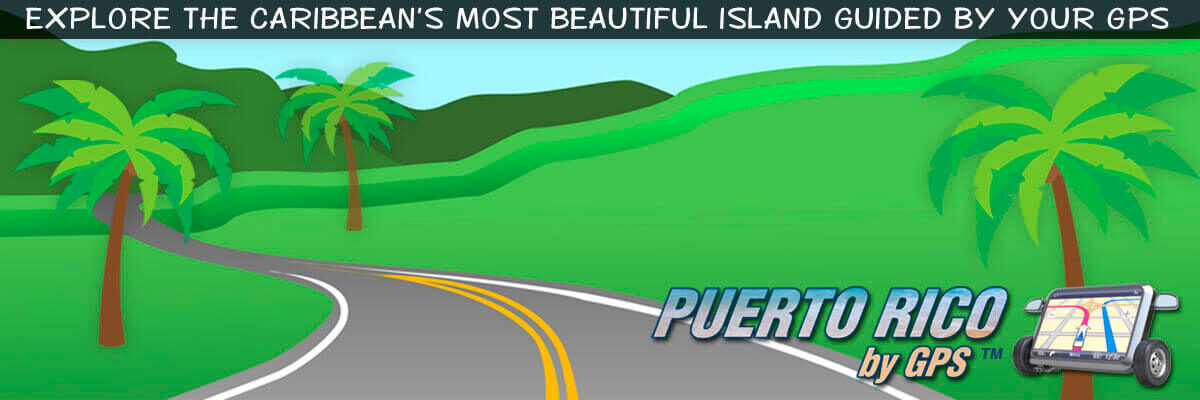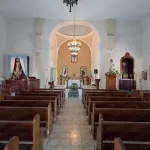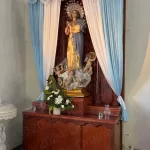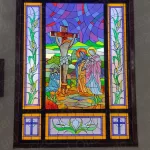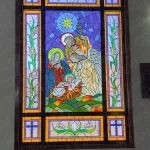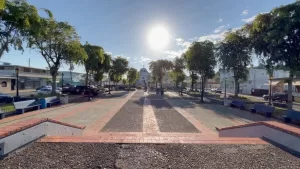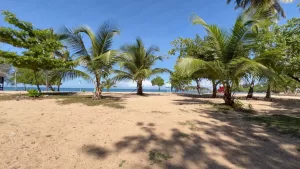
Little girl at Cerro Gordo Beach
Vega Alta is one of those towns that I hardly visit, unless I’m going to the beach. And even then, I don’t visit the beach —any beach— as much as I used to either. With that said, this week Zoraida and I visited the lovely town of Vega Alta, on the central-northern coast of Puerto Rico.
To us mere mortals Vega Alta would be pronounce “vega alta”, like you write it. But according to my friend, and Vega Alta hometown boy, Jorge Seijo, no real –vegalteño” would be caught dead pronouncing it that way. You can tell real “vegalteños” apart because they say: “vegalta”.
Vega Alta used to be part of a larger territory called “Las Vegas del Cibuco”, that was split in half by the Cibuco river. Then in 1775 they were actually split into “La Vega Alta de Espinosa (present day Vega Alta) and “La Vega Baja del Naranjal” (present day Vega Baja) which was founded a year later. To this date many people refer to these two towns as “Las Vegas del Cibuco” or simply —you guessed it— “las Vegas”.
So what is a “vega” anyway? Well, I’m glad you asked. A vega is a meadow, in the King’s English, which in turn is “a low ground by a river”. Hence, both Vega Alta and Vega Baja are frequently affected by floods during the rainy months.
Vega Alta is hardly a tourist destination. It’s one of those places where people live and go about their business, like so many others around the Island. However, if you look closely you’re going to run into interesting stories. And that’s what my wife and I did for a couple of hours.
Click on image to watch the video
As always, we arrived in Vega Alta early in the morning. It was 7:27 on the morning of April 5. The Catholic church was open so we walked right in.
Last week I got an email from one of my readers that was surprised to learn that I was raised in the protestant church. She thought I was a Catholic, being that our first stop is always the Catholic church.
Well, the truth is that I’m not a church-going Christian either way. I was just brought up in the protestant faith. The reason why we always visit the Catholic church is because Puerto Rico was originally a Spanish colony. Hence, the Island was predominantly Catholic. Some may argue that it still is, although the numbers might not support that notion.
This Spanish heritage resulted in beautiful temples throughout the Island, which in turn are tourists attractions for those who go around the world visiting old churches (yes, there is such a tourist). And Puerto Rico, I might add, has dozens and dozens of beautiful examples.
Catching these temples open can be a whole other challenge because many clerics celebrate mass early in the morning and close the temple until the evening. Why? Because of increasing vandalism and theft. They simply don’t have the resources or the people to watch over the temples during the day.
It’s a sad thing to say, but it’s a fact of modern life.
Vega Alta’s Immaculate Conception Church was built in 1813. It’s not spectacular on the outside by any stretch of the imagination. In fact, it’s rather “boxy”.
I’ve also said in the past that I’m not an architect. So my appreciation for these old structures is mainly based on the amount of “grandeur” that they might exhibit. That said, the Immaculate Conception Church might look rather “boxy”, with its flat roof and lack of a bell tower, but it more than makes up for it on the inside.
The interior has that “old world charm” with stained glass windows, chandeliers and sober decor. Altogether it evokes a feeling of peace and serenity that’s quite inviting.
- Immaculate Conception Church
(click on image to see it larger)
- Immaculate Conception Church
(click on image to see it larger)
- Immaculate Conception Church
(click on image to see it larger)
- Immaculate Conception Church
(click on image to see it larger)
- Immaculate Conception Church
(click on image to see it larger)
- Immaculate Conception Church
(click on image to see it larger)
- Immaculate Conception Church
(click on image to see it larger)
- Immaculate Conception Church
(click on image to see it larger)
- Immaculate Conception Church
(click on image to see it larger)
- Immaculate Conception Church
(click on image to see it larger)
And here’s another question that, if anything, shines another light on my ignorance about the Catholic faith. Why is it a church and not a Parish? What’s the difference? If by any chance you happen to know, leave a comment. I love to learn.
A few steps to the west of the Immaculate Conception Church is Dr. Gilberto Concepción de Gracia Square. It’s an unpretentious square, when you compare it to others that we’ve explored. But the city keeps it clean and in tip top shape. Across the square, on the northwest corner, is the old City Hall building, which is being remodeled to serve as the new Municipal Theater.
Concepción de Gracia was born in Vega Alta on July 9th, 1909. He was a lawyer, journalist, author, politician and the founder of the Puerto Rican Independence Party. During his tenure the Puerto Rican Independence Party obtained 20% of the vote and had 15 legislators elected into office, the highest amount it has ever had in its history.
Concepción de Gracia was not a doctor in medicine, but rather a doctor in law, specializing in civil rights and constitutional law. He trained at the University of Puerto Rico and at Washington D.C.’s prestigious George Washington University Law School.
In 1936, at the young age of 25, he relocated to New York City to defend Puerto Rican nationalist leader Pedro Albizu Campos and other members of the Party. After the trial he remained in the city defending the civil rights of other Hispanic workers.
And here are several other facts that I discovered while researching for my video and blog post about Vega Alta. Concepción de Gracia was also the great uncle of Puerto Rican artists René Pérez Joglar —also known as “Residente Calle 13”, singer Ileana Merced Cabra Joglar commonly known as “iLe”, and Lin-Manuel Miranda, who gained notoriety for his “Hamilton” and “In The Heights” plays.
After strolling around Dr. Concepción de Gracia Square for a while we walked north along the José Rosado Negrón, Esq. Pedestrian Walk to the new City Hall Building, that sits a few blocks north by State Road #2.
The area has public art, seating facilities and a bandstand for public events. One thing I noticed all around the city was the presence of city workers pruning parks and plazas. I mean, they were everywhere with their weedwackers and sheers clipping here and sweeping there. All in all the place looks pristine.
After reaching the new City Hall building we walked all the way back along the José Rosado Negrón, Esq. Pedestrian Walk to Muñoz Rivera Street, also known as municipal road 676. From there we walked east along 676 to a place called “La Placita De Güisín”. In case your Spanish is kind’a rusty, those two dots above the “u” are called a “dieresis” and they’re supposed to be pronounced “guee”. Hit the player below if you would like to hear how it’s pronounced.
In any case, why is “La Placita De Guisín” so important. Well, because we were told by several townspeople that several buildings in the area (including that one) were owned by “the Mirandas” and that there’s a gallery being built a couple of doors east that will hold Lin-Manuel Miranda memorabilia. It’s scheduled to open on May 2, 2024.
So what’s the connection? Well, Lin-Manuel Miranda was born in New York City to Puerto Rican parents. During his childhood he would spend at least a month of every year at his grandparent’s house in “you guessed it”, the little town of Vega Alta.
Hence Miranda has a special place in his heart for Puerto Rico and has always defended its culture.
There was one place remaining in our visit to Vega Alta and it was all the way across town. It was also what gave way to the posts name. Of course, I’m talking about the beautiful Cerro Gordo Beach.
You won’t find Cerro Gordo in most of the Puerto Rico Tourism Company’s publications. The fact is that most visitors to the Island hardly leave the San Juan Metroplex altogether. And that’s their loss and the entire reason for Puerto Rico By GPS’ existence.
Just ask any mainlander what’s the best beach in Puerto Rico and chances are that he’ll say “Flamenco”. After all, it constantly ranks among the best beaches in the world in publications like Conde Nast Traveler. But, hey, Flamenco is in Culebra, a small Island east of the larger Island of Puerto Rico.
To get there you’ll only have two options: a “puddle jumper” and the ferry. The first can be quite expensive, especially if you party is numerous and the ferry is simply a tragedy.
But Puerto Rico has dozens of other beaches that are also great. In fact, I wrote an entire book about the subject titled “Puerto Rico Beach By Beach”. My wife and I visited 53 of Puerto Rico’s most gorgeous beaches, took pictures, shot video and researched every little detail about them so that you wouldn’t have to.
I know. It’s hard work, but someone had to do it. Back to our story…
When I was a young man I studied my first two years of college at the University of Puerto Rico’s regional college in Bayamón, a larger city that’s a few miles southeast of Vega Alta. Most of our beach escapades took place at Cerro Gordo Beach.
- Cerro Gordo Beach
(click on image to see it larger)
- Cerro Gordo Beach
(click on image to see it larger)
- Cerro Gordo Beach
(click on image to see it larger)
- Cerro Gordo Beach
(click on image to see it larger)
And believe me, the place is and has always been gorgeous. The water is a crystal clear turquoise blue, the surf is usually under an inch high and the sand is pristine white.
And here are a few extra tips that I’ve picked up throughout the years. Cerro Gordo is a balneario. That means ‘public beach” in Spanish. Most balnearios are closed on Mondays. They’re closed for maintenance and cleaning.
That means that if you go there on a Tuesday morning it’ll be “sparkling”.
Furthermore, Puerto Ricans mostly visit their beaches on the weekends. That means that if you’d like to have the place to yourself, your best bet is to go there on a Tuesday, Wednesday or Thursday.
And, of course, like most balnearios you’ll have lifeguards, safety buoys, signage, showers, restrooms, concession stands and ample parking. Oh, and did I mention that the whole thing is free?
That’s right!!! Well, sort of, because you will have to pay for the parking. But that was a measly $5.
All in all, a day at Cerro Gordo is sure to be a wonderful experience at a minimal cost.
The easiest way to get back to the San Juan Metroplex from Cerro Gordo Beach is through the neighboring town of Dorado. You can choose to explore it as well, but we’ll be doing that in our next post.
For now just take road 690 going south until you reach the intersection with road 693. Turn left on 693 (that will actually be going east) and follow the road all the way through the town of Dorado, over the “La Plata” river and to the intersection with road 165. Turn left on road 165 and follow it until you reach exit 7B.
This stretch will be looooooooong. You’ll be driving along the north coast of the town of Toa Baja first, with the beach on your left hand side, then by Puerto Rico’s decaying power plants (that’s a story for another day), then along the Cataño dock yards and finally by the Federal Prison on your right hand side. Then you’ll go under the PR-22 toll road and finally reach exit 7B on your left hand side.
Turn left on exit 7B and you’ll get on PR-22 going towards the Minillas Tunnel and the San Juan/Condado area.
And talking about San Juan, if you’re planning to visit the Old City, save yourself the hassle of traditional city tours. They’re expensive and you’ll be herded along with people that won’t necessarily share your interests.
Instead, order The Old San Juan Walking Tour. It’s packed with useful information about all the main attractions, as well as every GPS coordinate and two hours of exclusive online video. That way you’ll be able to —visit before you visit— and hit the ground running when you arrive in the Old City.
See you next time!
©2024,Orlando Mergal, MA
____________________
Bilingual Content Creator, Blogger, Podcaster,
Author, Photographer and New Media Expert
Tel. 787–750-0000, Mobile 787–306-1590
